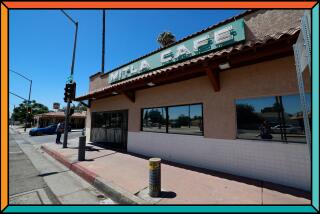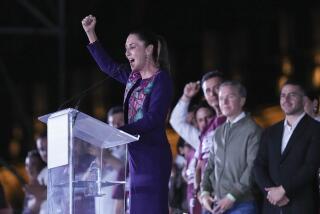Aquino Cabinet Crisis Is Not Left vs. Right
- Share via
NEW YORK — Last week’s feud between the Filipino military and Cabinet ministers Joker Arroyo and Teodoro (Teddy Boy) Locsin Jr. has been portrayed as right-wing officers versus left-wing civilians. It is an analysis that misses the point. While Arroyo’s background as a human-rights lawyer did nothing to endear him to the military, there are leading figures in the Aquino government whose human-rights credentials are equal and whose political credentials are markedly to the left of Arroyo’s. Locsin, who worked for Ferdinand E. Marcos and wrote speeches for Juan Ponce Enrile in the past, could hardly be less a leftist.
The clash between the military and the two ministers is much more one of style, culture and class--exacerbated by the widespread public perception that the Aquino administration has been ineffective at the business of government. The military’s greatest concern, naturally, has been the government’s failure to deliver the large increases in foreign military aid and equipment they believed they were promised.
But Arroyo and Locsin--who have forged a two-man alliance within the Cabinet--have come under even stronger criticism from the business community’s “Council of Trent” (after the 16th-Century Roman Catholic council that condemned the Reformation and undertook Catholic reform) for dropping the ball, both in day-to-day management issues such as working with foreign investors and on key economic issues, such as processing major loans. The pair has been responsible for highly politicized appointments to companies sequestered from Marcos (particularly the San Miguel Corp.), which are major forces in the national economy.
Arroyo and Locsin both delight in shocking the public with outrageous statements and antics. (Last week Arroyo called the army press secretary a “Goebbels,” after the Nazi propagandist; last spring, Locsin was seen on television giving the finger to a crowd of demonstrators.) But within the government they are blamed for forming the President’s cordon sanitaire . They claim she wants to be sheltered from unsolicited opinion, but other Filipinos, from a wide political spectrum, including other Cabinet officials, believe that the presidential offices have become a sealed-off political hothouse in which Arroyo and Locsin “protect” Aquino from people and information that don’t conform with their agendas.
Even Arroyo’s former colleagues from the human-rights movement are disappointed in his performance: In his 18 months in the country’s most powerful appointed position, the human-rights situation has steadily worsened. The military carried out two large-scale massacres--at Mendiola Bridge in Manila and in Lupao in central Luzon--earlier this year that rivaled any committed during Marcos’ time. International human-rights organizations are recording a steady increase in extrajudicial killings and disappearances. They add that not one military officer or soldier has been convicted of a human-rights abuse under Aquino.
The particular complexity of Filipino politics dictates that there are never only two sides to any issue, and there is no reason to think that Arroyo’s and Locsin’s various enemies are each other’s friends. Manila’s Cabinet feud does not break down into “anti-communist” versus “soft on communism.”
The conflict reflects the vast gulf between the educated Manila elite, from whom Aquino selected her government, and the predominantly rural underclass that provides most of the country’s soldiers. It includes a lasting personal grudge against the institution that held Benigno Aquino Jr. and other political prisoners in a succession of military camps, subjecting their lawyers and families to humiliating searches and threats. It involves a military body that is unsure of itself and its own internal structure--stripped of the command installed by Marcos, who used loyal officers from his home province of Ilocos. Today’s officers’ corps is overburdened with figures from Fidel Ramos’ generation, regarded as over the hill, and brash young officers who, blocked from rapid promotion, lend themselves to myriad armies-within-the-army, such as the Guardians, the Freemasons and the wing of the Reform the Army Movement (RAM) that led last month’s aborted coup.
The military, suffering from a vacuum of leadership, looked to the Aquino administration to address its problems, both political and professional. But it is hard for administration and military to work together when the administration fears the military even more than the guerrillas.
The Philippines’ military men are wrong if they feel that Aquino and her ministers Arroyo and Locsin singled them out for “benign neglect.” It is a sentiment shared by many in the country, including the military’s sworn enemies. But to a large extent the bone of contention is that old one called management style. Everyone agrees that streamlining the machinery and the paper work in the presidential offices is one of the most urgent requirements for the moment. But even if Arroyo and Locsin leave their posts, at best it will mean that policy debates can take place more efficiently--not that they will be resolved.
More to Read
Sign up for Essential California
The most important California stories and recommendations in your inbox every morning.
You may occasionally receive promotional content from the Los Angeles Times.










